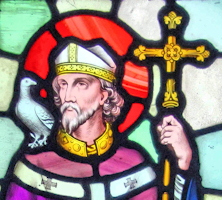Ordinary Time: March 1st
Tuesday of the Eighth Week of Ordinary Time; Fat Tuesday or Mardi Gras; David of Wales (Solemnity, Wales; Feast, England)
Other Commemorations: St. David of Wales (RM; Feast, Wales and England)
» Enjoy our Liturgical Seasons series of e-books!
Today the Church in Wales and England celebrates the feast of St. David, bishop and patron of Wales. Very little is known about the life of St. David (Dewi Sant). He belonged to that great monastic movement which became influential in Wales in the sixth century and which had links with monasticism in Gaul and in Ireland. The earliest references to David are in the Irish Annals. Many churches across South Wales claim David as their founder. His chief foundation was at Mynyw or Menevia in Dyfed. He was canonized by Pope Callistus II in 1123.
It is also the day before Ash Wednesday, called Mardi Gras or Fat Tuesday. Traditionally, it is the last day for Christians to indulge before the sober weeks of fasting that come with Lent. Formally known as Shrove Tuesday, Mardi Gras has long been a time of extravagant fun for European Christians. In many southern states of the USA Mardi Gras is a traditional holiday. The most famous celebration takes place in New Orleans, Louisiana. It has been celebrated there on a grand scale, with masked balls and colorful parades, since French settlers arrived in the early 1700s.
Please see Recipes, Activities, Prayers and Documents for Tuesday Before Ash Wednesday
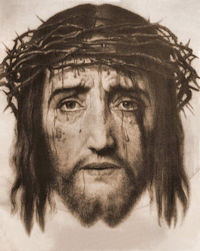 Today is a traditional honoring of the Holy Face of Jesus. On April 17th, 1958, His Holiness Pope Pius XII confirmed the Feast of the Holy Face of Jesus as a movable feast on Shrove Tuesday (Tuesday before Ash Wednesday) for all the dioceses and religious orders who would ask for the Indult from Rome. Devotion to the Holy Face was revealed by Jesus to Sr. Marie of St. Peter (1816-1848) a Carmelite nun of Tours in France. The primary purpose of the devotion is to make reparation for sins against the first three commandments. Learn more about this devotion at Holy Face Devotion, the Holy Face Association and this article for more information.
Today is a traditional honoring of the Holy Face of Jesus. On April 17th, 1958, His Holiness Pope Pius XII confirmed the Feast of the Holy Face of Jesus as a movable feast on Shrove Tuesday (Tuesday before Ash Wednesday) for all the dioceses and religious orders who would ask for the Indult from Rome. Devotion to the Holy Face was revealed by Jesus to Sr. Marie of St. Peter (1816-1848) a Carmelite nun of Tours in France. The primary purpose of the devotion is to make reparation for sins against the first three commandments. Learn more about this devotion at Holy Face Devotion, the Holy Face Association and this article for more information.
Shrove Tuesday
The day before Ash Wednesday is a celebration marking the start of the penitential season of Lent. Before Lent—a time of prayer, fasting and penance through a period of 40 days until Easter — Catholics and others celebrate with festivities known by several names.
In the United States, it’s most commonly known as Mardi Gras, French for Fat Tuesday. The tradition includes consuming foods containing animal fat before the beginning of Lent. Catholics enjoy a day of festivities, sometimes hosting their own carnivals or parties. The largest Mardi Gras celebration in the United States takes place in New Orleans. The celebration is known as Carnival in other parts of the world.
Catholics also prepare for Lent by spiritually removing themselves of sin through the Sacrament of Reconciliation. That is why this day is also referred to as Shrove Tuesday, from the old English word shrive, meaning to confess all sins.
Some countries, including England and Ireland, celebrate Pancake Day by consuming what else — pancakes. For centuries, it’s been a tradition to eat pancakes or other foods made with butter, eggs and fat, which would be given up during Lent.
No matter what it’s called, the day before Lent is a reminder of the sacrifice that is to come in the next 40 days. We also are reminded of the sacrifices Jesus made as he fasted and prayed for 40 days after his Baptism and before the beginning of his ministry.
Catholics are called to fast, pray and confess sins during this penitential season. For more ideas on making a good Lent, see Recipes and Activities for Mardi Gras.
—Excepted from the Archdiocese of St. Louis
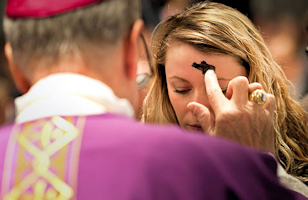 Preparing for Lent
Preparing for Lent
No Lent is worthy of the name without a personal effort of self-reformation, of leading a life more in accordance with God's commands and an attempt by some kind of voluntary self-denial to make reparation for past negligence. But the Church, together with the personal effort which she requires of all of us, her children, sets up in the sight of God the cross of Christ, the Lamb of God who took upon Himself the sins of man and who is the price of our redemption. As Holy Week approaches the thought of the passion becomes increasingly predominant until it occupies our whole attention, but from the very beginning of Lent it is present, for it is in union with the sufferings of Christ that the whole army of Christians begins on the holy "forty days", setting out for Easter with the glad certitude of sharing in His resurrection.
"Behold, now is the acceptable time, behold, now is the day of salvation." The Church puts Lent before us in the very same terms that formerly she put it before the catechumens and public penitents who were preparing for the Easter graces of baptism and sacramental reconciliation. For us, as it was for them, Lent should be a long retreat, one in which under the guidance of the Church we are led to the practice of a more perfect Christian life. She shows us the example of Christ and by fasting and penance associates us with his sufferings that we may have a share in His redemption.
We should remember that Lent is not an isolated personal affair of our own. The Church avails herself of the whole of the mystery of redemption. We belong to an immense concourse, a great body in which we are united to the whole of humanity which has been redeemed by Christ. The liturgy of this season does not fail to remind us of it.
This, then, is the meaning of Lent for us: a season of deepening spirituality in union with the whole Church which thus prepares to celebrate the Paschal mystery. Each year, following Christ its Head, the whole Christian people takes up with renewed effort its struggle against evil, against Satan and the sinful man that each one of us bears within himself, in order at Easter to draw new life from the very springs of divine life and to continue its progress towards heaven.
—Excerpted from The Saint Andrew Daily Missal
Things to Do
Here are a few suggestions to help you celebrate the final day before Lent.
- Today is Fat Tuesday, or Mardi Gras! Try some of the traditional recipes linked here. When eggs were among the foods that were forbidden by the Church during Lent, people would use them up on Fat Tuesday by mixing up large quantities of pancakes or doughnuts (also known as fastnachts).
- Read Maria von Trapp's explanation of the traditions associated with Carnival, or Fat Tuesday here.
- Sing this American favorite, Turkey in the Straw, with your children as part of your Mardi Gras celebrations.
- Discuss Jesus' Gospel teaching for today, He who would be first must be last, with your children and ask them how they can put others in the family before themselves. Keep it simple and practical — setting the table, washing the dishes, folding laundry, watching the littler ones, doing homework right away.
- What does it mean to become a child spiritually, that we may enter Heaven and be received by Christ Himself? We can learn much from St. Therese of the Child Jesus about spiritual childhood. Begin reading her autobiography, Story of a Soul. ICS Publications with John Clark, OCD's critical edition is considered the best.
- Read Fr. William Saunder's article, Shrove Tuesday and Shrovetide, from the Catholic Culture Library.
- Read Jennifer Gregory Miller's two part explanation on Carnival: Carnival Part One: A Season of Contrasts and Carnival: Part Two, the Final Countdown
St. David of Wales
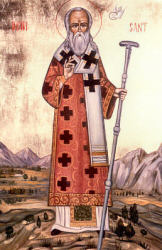 All the information we have about David is based on the unreliable eleventh-century biography written by Rhygyfarch, the son of Bishop Sulien of St. David's. According to it David was the son of King Sant of South Wales and St. Non, became a priest, studied under St. Paulinus on an unidentified island for several years, and then engaged in missionary activities, founding some dozen monasteries, the last of which, at Mynyw (Menevia) in southwestern Wales, was noted for the extreme asceticism of its rule, which was based on that of the Egyptian monks. David attended a synod at Brefi, Cardiganshire, in about 550 where his eloquence is said to have caused him to be elected primate of the Cambrian Church with the understanding that the episcopal see would be moved from Caerleon to Mynyw, now St. David's. He was supposedly consecrated archbishop by the patriarch of Jerusalem while on pilgrimage to the Holy Land, and a council he convened, called the Synod of Victory because it marked the final demise of Pelagianism, ratified the edicts of Brefi, and drew up regulations for the British Church. He died at his monastery at Mynyw, and his cult was reputedly approved by Pope Callistus II about 1120. Even his birth and death dates are uncertain, ranging from c. 454 to 520 for the former and from 560 to 601 for the latter.
All the information we have about David is based on the unreliable eleventh-century biography written by Rhygyfarch, the son of Bishop Sulien of St. David's. According to it David was the son of King Sant of South Wales and St. Non, became a priest, studied under St. Paulinus on an unidentified island for several years, and then engaged in missionary activities, founding some dozen monasteries, the last of which, at Mynyw (Menevia) in southwestern Wales, was noted for the extreme asceticism of its rule, which was based on that of the Egyptian monks. David attended a synod at Brefi, Cardiganshire, in about 550 where his eloquence is said to have caused him to be elected primate of the Cambrian Church with the understanding that the episcopal see would be moved from Caerleon to Mynyw, now St. David's. He was supposedly consecrated archbishop by the patriarch of Jerusalem while on pilgrimage to the Holy Land, and a council he convened, called the Synod of Victory because it marked the final demise of Pelagianism, ratified the edicts of Brefi, and drew up regulations for the British Church. He died at his monastery at Mynyw, and his cult was reputedly approved by Pope Callistus II about 1120. Even his birth and death dates are uncertain, ranging from c. 454 to 520 for the former and from 560 to 601 for the latter.
—Excerpted from Dictionary of Saints, John J. Delaney
Patronage: doves; Wales
Symbols and Representation: leek; dove; daffodil; Celtic bishop with long hair, beard and dove on shoulder; bishop holding cathedral; preaching on a hill; man standing on a mound with a dove on his shoulder
Highlights and Things to Do:
- Read more about St. David:
- Find out more about the Welsh customs surrounding this day here and here.
- St. David was buried in St. David's Cathedral in Pembrokeshire, Wales. From Wiki: "His shrine was a popular place of pilgrimage throughout the Middle Ages. During the 10th and 11th centuries the Cathedral was regularly raided by Vikings, who removed the shrine from the church and stripped off the precious metal adornments. In 1275 a new shrine was constructed, the ruined base of which remains to this day, which was originally surmounted by an ornamental wooden canopy with murals of David, Patrick and Denis. The relics of David and Justinian of Ramsey Island were kept in a portable casket on the stone base of the shrine. It was at this shrine that Edward I came to pray in 1284. During the reformation Bishop Barlow (1536–48), a staunch Protestant, stripped the shrine of its jewels and confiscated the relics of David and Justinian."
- So often the celebrations forget the historical and religious contributions of St. David. Read this 16 things you (probably) didn’t know about St David’s Day traditions.
- Leeks and daffodils are visually prominent in this day. Cook something with leeks, and decorate with the sign of spring--beautiful yellow daffodils.
- See Catholic Cuisine for some food ideas for St. David's Day.
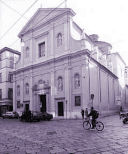
Friday of the Second Week of Lent
Station with San Vitale (St. Vitalis):
The Station for today is in the church of St. Vitalis, martyr, the father of the two illustrious Milanese martyrs, Sts. Gervasius and Protasius. The church was built about 400, and consecrated by Pope Innocent I in 401/2. The dedication to St. Vitalis and his family was given in 412. The church has been rebuilt several times, of which the most comprehensive rebuilding was that of Pope Sixtus IV before the 1475 Jubilee. It was then granted to Clerics Regular.
For more on San Vitale, see:
For further information on the Station Churches, see The Stational Church.





